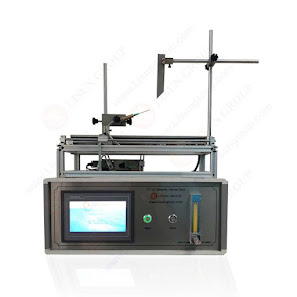Introduction of ANSI/UL 94 horizontal vertical flame test
Underwriters Laboratories (UL), an independent testing and certification organization, developed the ANSI/UL 94 standard to assess the combustibility of plastic materials. The standard is known as "ANSI/UL 94." The standard evaluates plastics using a number of different tests, one of which is the horizontal and vertical flame test. This test evaluates how easily flames can be started on plastic materials and how quickly they can spread.
In order to carry out the
horizontal flame test, also known as the UL 94 HB, a sample of the plastic
material is arranged in a horizontal position and then subjected to a flame for
the amount of time that has been determined. The objective of the test is to
determine how easily the material can be ignited and how quickly flames can
spread over its surface.
The vertical flame test,
also known as UL 94 V, is carried out by holding a specimen of the plastic
material vertically in a flame for the amount of time that is indicated in the
test. The objective of the test is to determine how easily the specimen ignites
and how quickly flames extend vertically along its length.
The horizontal flame test and the vertical flame test are normally carried out by following these stages in order:
- Obtain the plastic material and then prepare it in accordance with the testing protocol detailed in ANSI/UL 94. This is the first step in the preparation process. This can include chopping the material into a certain size or form and then putting it on the instrument that will be used for the test.
- Ignition of the Flame: The process of lighting a flame requires the use of a certain ignition source, such as a Bunsen burner or a propane torch.
- Contact with the Plastic Material: After bringing the flame into contact with the plastic material, a stopwatch is used to record the amount of time it takes for the flame to grow to a certain length or for the material to catch fire and start burning.
- Keeping Track of the Results The results of the test are kept track of, including the amount of time it took for the flame to reach the required length, as well as the amount of time it took for the material to catch fire and burn.
- Evaluation of Results In order to identify whether or not the plastic material being tested is flammable, the results of the test are reviewed using the applicable standard, which in this case is ANSI/UL 94.
- Repeatability: In order to guarantee accurate and reliable findings, it is recommended that the testing technique be carried out many times using the same kind of plastic and under the same environmental circumstances.
- Safety During the course of the test, the testing gear need to be outfitted with various safety mechanisms, such as an alarm and an automatic shut-off switch, in order to guarantee the operator's well-being.
In conclusion, the
flammability of plastic materials may be determined using the ANSI/UL 94
standard, which was developed by UL. The horizontal and the vertical flame test
are two examples of the kinds of evaluations that are included in the standard
with regard to the ignition and spread of flames on plastic materials. In the
method for the test, the plastic material will be subjected to a flame, the
results will be recorded, and then the results will be evaluated in accordance
with the applicable standard. The process for the test should be performed
several times to assure accurate and consistent findings, and the testing
equipment should be outfitted with safety elements to ensure the operator's
safety while the test is being performed.

.jpg)
Comments
Post a Comment